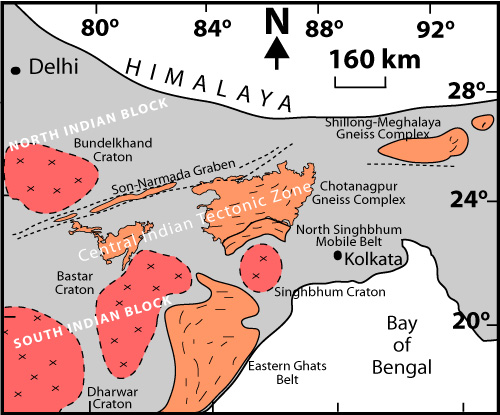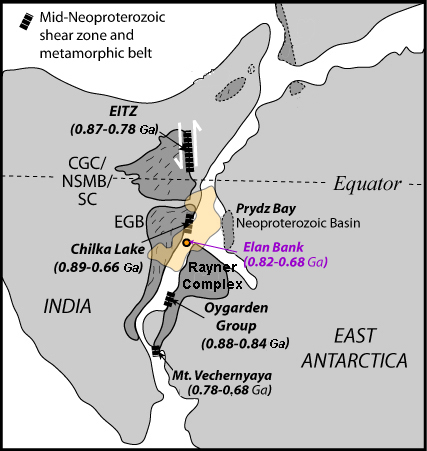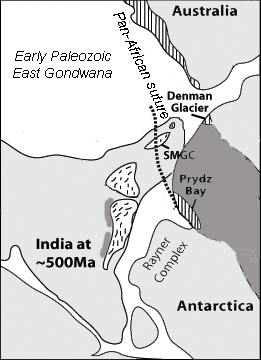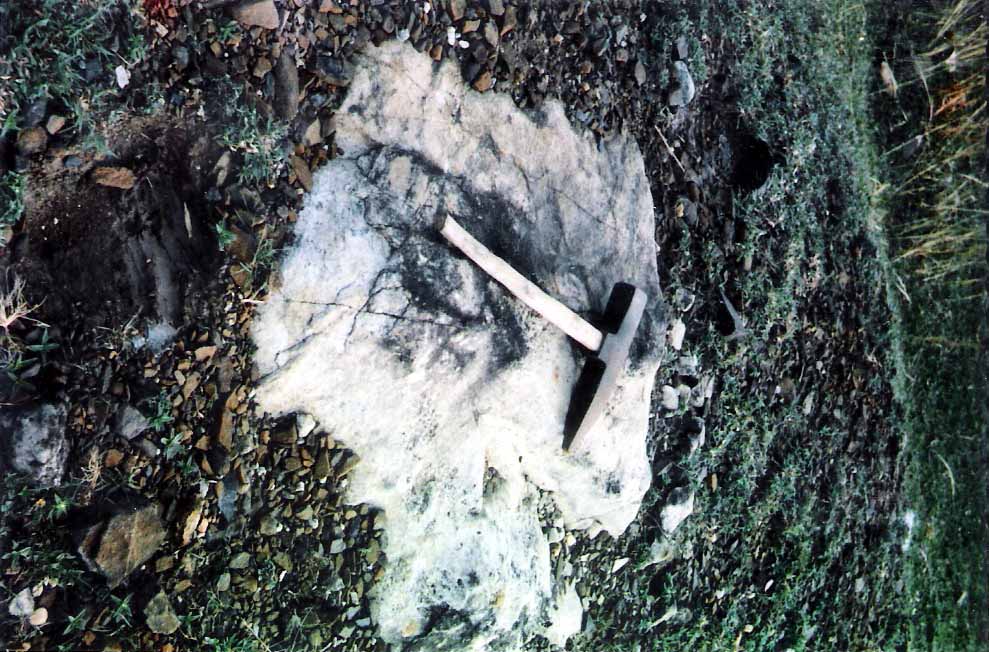The significance of Indian Proterozoic gneiss complexes in Rodinia and Gondwana supercontinent reconstructions
 The Indian Shield was formed by a terminal collision between the northern and the southern Indian continental blocks (NIB and SIB) in Late Mesoproterozoic-Early Neoproterozoic after initial plate interactions in Early Mesoproterozoic. The Late Mesoproterozoic-Early Neoproterozoic was also the time when Rodinia was assembled, but it is unclear whether India was a part of Rodinia. After Rodinia disintegrated in Mid-Neoproterozoic, the resulting blocks reassembled in Early Paleozoic to form Gondwana. In classical reconstructions, the position of India with respect to Australia-Antarctica is approximately the same in Rodinia and Gondwana. The granulite gneiss complexes of the Central Indian Tectonic Zone (CITZ) comprising the Sausar Belt in central India and the Chotanagpur Gneissic Complex (CGC) in eastern India, the Shillong-Meghalaya Gneissic Complex (SMGC) in northeastern India, and the Eastern Ghats Belt (EGB) along the Indian east coast preserve key evidence of the above mentioned tectonic events. This study is an attempt to correlate the tectono-metamorphic histories of these gneissic complexes through P-T pseudosection analysis, U-Pb isotope zircon dating with isotope dilution-thermal emission mass spectrometry (ID-TIMS), and U-Th-Pb monazite chemical dating with the electron microprobe (EPMA).
The Indian Shield was formed by a terminal collision between the northern and the southern Indian continental blocks (NIB and SIB) in Late Mesoproterozoic-Early Neoproterozoic after initial plate interactions in Early Mesoproterozoic. The Late Mesoproterozoic-Early Neoproterozoic was also the time when Rodinia was assembled, but it is unclear whether India was a part of Rodinia. After Rodinia disintegrated in Mid-Neoproterozoic, the resulting blocks reassembled in Early Paleozoic to form Gondwana. In classical reconstructions, the position of India with respect to Australia-Antarctica is approximately the same in Rodinia and Gondwana. The granulite gneiss complexes of the Central Indian Tectonic Zone (CITZ) comprising the Sausar Belt in central India and the Chotanagpur Gneissic Complex (CGC) in eastern India, the Shillong-Meghalaya Gneissic Complex (SMGC) in northeastern India, and the Eastern Ghats Belt (EGB) along the Indian east coast preserve key evidence of the above mentioned tectonic events. This study is an attempt to correlate the tectono-metamorphic histories of these gneissic complexes through P-T pseudosection analysis, U-Pb isotope zircon dating with isotope dilution-thermal emission mass spectrometry (ID-TIMS), and U-Th-Pb monazite chemical dating with the electron microprobe (EPMA).
Intrusion of peraluminous granite at 1697 ± 17 Ma in the graben north of CGC indicates a continuity of the Mahakoshal Belt along the northern boundary of CGC. The oldest phase of granulite-facies metamorphism along the northern margin of CGC and in northwestern SMGC occurred in the Late Paleoproterozoic. Monazite of c. 1.8-1.6 Ga age occurs in the cores of garnet in metapelite in the northern part of the E-W oriented Eastern Indian Tectonic Zone (EITZ) at the eastern margin of CGC. P-T pseudosection analysis in the MnCNKFMASH-PYCeF system shows that the monazite inclusions formed at ~5-7 kb/ >550 oC during high-grade metamorphism that followed a counterclockwise P-T path. This metamorphism can be correlated with the granulite-facies metamorphism at ~1.6 Ga at the southern boundary of Sausar Belt that occurred in response to a collision of the SIB with an island arc concluded in other studies. Thus, the ~1.6 Ga collision zone extends over 650 km in an ENE-WSW direction between Sausar Belt and northeastern CGC. In northwestern SMGC, the anatectic metapelite granulites were metamorphosed at 1609 ± 9 Ma, also along a counterclockwise P-T path with <3 kb/600 oC progade, ~8 kb/850 oC peak, and ~5.5 kb/630 oC retrograde conditions. However, the SMGC became aligned with CGC only after Tonian-Cryogenian shearing in the EITZ. Thus, it is unclear whether the collision zone extends up to the SMGC.
The Late Paleoproterozoic metamorphism was followed by the emplacement of Bengal Anorthosite in southeastern CGC at 1550 ± 2 Ma. Subsequent high-grade Grenvillian metamorphism at 975 ± 67 Ma in northwestern CGC granite gneiss provides evidence for an Early Neoproterozoic terminal collision between the SIB and the NIB. On the other hand, The N-S foliation in northeastern CGC near EITZ is the manifestation of a Grenvillian collision between the CGC and the Dinajpur Block to its east. This collision is recorded by high-grade metamorphism in northeastern CGC metapelite granulite (clockwise P-T path with prograde conditions from <7 kb/700 oC to ~14 kb/825 oC followed by decompression) at 995-950 Ma, and in the Bengal Anorthosite at 947 ± 27 Ma. Evidently, the northward collision of the SIB with NIB was coeval with a westward collision of the Dinajpur Block with CGC (and probably NIB) and a westward collision of the NIB with the Marwar Block, resulting in the formation of the Indian Shield at c. 1.0 Ga. Furthermore, the collision between EGB and Rayner Complex of East Antarctica was also coeval as recorded by Grenvillian ages in EGB granulites and the emplacement of Chilka Lake Anorthosite in northeastern EGB at 983.0 ± 2.5 Ma. All these Early Neoproterozoic collisonal events may be correlated with the assembly of Rodinia.
 The N-S oriented EITZ is a zone of ductile deformation, sinistral shearing and high-grade metamorphism that overprints the broadly E-W fabrics of the CGC, North Singhbhum Mobile Belt (NSMB) and Singhbhum Craton (SC) at their eastern margin in the Mid-Neoproterozoic (876-784 Ma). Metamorphism occurred along a counterclockwise P-T path with a prograde stage from 8.93 kb/794 oC to 8.80 kb/809oC, loading to 10.22 kb/777 oC and isothermal decompression to 6.83 kb/787 oC. This P-T path is distinctly different from the clockwise P-T path of Grenviallian metamorphism in northeastern CGC. The burial and exhumation rates in northeastern CGC and EITZ are also remarkably different. In northeastern CGC, the burial (3.5-8.4 km/Ma) and exhumation (2.2-7.2 km/Ma) rates were similar during the c. 1.0 Ga metamorphism. By contrast, exhumation (15-27 km/Ma) was ~8-25 times faster than burial (1.1-2.0 km/Ma) in northern EITZ during the Tonian-Cryogenian shearing at 876-784 Ma. Thus, the EITZ originated by reactivation of the CGC-Dinajpur collision zone in Tonian-Cryogenian when sinistral shearing between the CGC and the Dinajpur Block moved the SMGC into alignment with the northern margin of CGC. Similar Tonian-Cryogenian dates from near Chilka Lake in EGB, Elan Bank of Kerguelen Plateau (where granulites followed a 8.3kb/766 oC to 6.7kb/737 oC retrograde P-T path), and Oygarden Group and Mt. Vechernyaya of Rayner Complex indicate that the EITZ was an ~1800 km long Neoproterozoic orogenic belt stretching from eastern India through Kerguelen Plateau to East Antarctica. Sinistral shearing in the EITZ at 876-784 Ma indicates a distinct period of southward movement of the Indian block with respect to Australia-Antarctica. Thus, rifting between India and Australia-Antarctica and northwestward movement of India during the break-up of Rodinia, as proposed in classical models, occurred after ~780 Ma.
The N-S oriented EITZ is a zone of ductile deformation, sinistral shearing and high-grade metamorphism that overprints the broadly E-W fabrics of the CGC, North Singhbhum Mobile Belt (NSMB) and Singhbhum Craton (SC) at their eastern margin in the Mid-Neoproterozoic (876-784 Ma). Metamorphism occurred along a counterclockwise P-T path with a prograde stage from 8.93 kb/794 oC to 8.80 kb/809oC, loading to 10.22 kb/777 oC and isothermal decompression to 6.83 kb/787 oC. This P-T path is distinctly different from the clockwise P-T path of Grenviallian metamorphism in northeastern CGC. The burial and exhumation rates in northeastern CGC and EITZ are also remarkably different. In northeastern CGC, the burial (3.5-8.4 km/Ma) and exhumation (2.2-7.2 km/Ma) rates were similar during the c. 1.0 Ga metamorphism. By contrast, exhumation (15-27 km/Ma) was ~8-25 times faster than burial (1.1-2.0 km/Ma) in northern EITZ during the Tonian-Cryogenian shearing at 876-784 Ma. Thus, the EITZ originated by reactivation of the CGC-Dinajpur collision zone in Tonian-Cryogenian when sinistral shearing between the CGC and the Dinajpur Block moved the SMGC into alignment with the northern margin of CGC. Similar Tonian-Cryogenian dates from near Chilka Lake in EGB, Elan Bank of Kerguelen Plateau (where granulites followed a 8.3kb/766 oC to 6.7kb/737 oC retrograde P-T path), and Oygarden Group and Mt. Vechernyaya of Rayner Complex indicate that the EITZ was an ~1800 km long Neoproterozoic orogenic belt stretching from eastern India through Kerguelen Plateau to East Antarctica. Sinistral shearing in the EITZ at 876-784 Ma indicates a distinct period of southward movement of the Indian block with respect to Australia-Antarctica. Thus, rifting between India and Australia-Antarctica and northwestward movement of India during the break-up of Rodinia, as proposed in classical models, occurred after ~780 Ma.
 Early Paleozoic high-grade metamorphism and thrusting at the contact of EGB with the Archean cratons of India, as well as at the southeastern margin of Rayner Complex, occurred during the Pan-African assembly of Gondwana. During this time (Late Cambrian, 494 ± 6 Ma), the central part of SMGC was intensely reworked by granulite-facies metamorphism along a clockwise P-T path with near isobaric prograde heating between 635 oC and 730 oC at ~5.7-5.5 kb, peak metamorphism at ~5.5 kb/730 oC, and cooling between 650 oC and 595 oC at 3.4-3.2 kb. The retrograde segment of this P-T path is similar to that from Prydz Bay in East Antarctica. Thus, the Prydz Bay Pan-African suture passes through SMGC, and the Early Paleozoic (494 ± 6 Ma) metamorphism in SMGC may be correlated with a collision between India and Australia-Antarctica during the assembly of East Gondwana.
Early Paleozoic high-grade metamorphism and thrusting at the contact of EGB with the Archean cratons of India, as well as at the southeastern margin of Rayner Complex, occurred during the Pan-African assembly of Gondwana. During this time (Late Cambrian, 494 ± 6 Ma), the central part of SMGC was intensely reworked by granulite-facies metamorphism along a clockwise P-T path with near isobaric prograde heating between 635 oC and 730 oC at ~5.7-5.5 kb, peak metamorphism at ~5.5 kb/730 oC, and cooling between 650 oC and 595 oC at 3.4-3.2 kb. The retrograde segment of this P-T path is similar to that from Prydz Bay in East Antarctica. Thus, the Prydz Bay Pan-African suture passes through SMGC, and the Early Paleozoic (494 ± 6 Ma) metamorphism in SMGC may be correlated with a collision between India and Australia-Antarctica during the assembly of East Gondwana.
Anorthosite massifs
 Several large anorthosite massifs occur in the Proterozoic granulite complexes of eastern India. At the southeastern margin of CGC, the Bengal Anorthosite was emplaced at 1550 ± 2 Ma and metamorphosed at 947 ± 27 Ma during Rodinia assembly. Small bodies of Late Paleoproterozoic to Early Mesoproterozoic anorthosite of different generations associated with metamorphosed layered mafic-ultramafic sequences also occur in the CGC. The Bengal Anorthosite massif is morphologically different from the smaller anorthositic bodies. Surface and subsurface mineralogical and geochemical investigations indicate cyclic layering with depth in the massif that is possibly related to derivation and emplacement of melt in discrete batches. Sub-parallel, E-W oriented, discontinuous lenses of metabasite occur within and outside the anorthosite massif. Field evidence indicates that the metabasites and the anorthosite are coeval, but chemical compositions suggest that they are not comagmatic. Geochemical characteristics indicate a mantle origin for the anorthosite and a lower crustal origin for the metabasites.
Several large anorthosite massifs occur in the Proterozoic granulite complexes of eastern India. At the southeastern margin of CGC, the Bengal Anorthosite was emplaced at 1550 ± 2 Ma and metamorphosed at 947 ± 27 Ma during Rodinia assembly. Small bodies of Late Paleoproterozoic to Early Mesoproterozoic anorthosite of different generations associated with metamorphosed layered mafic-ultramafic sequences also occur in the CGC. The Bengal Anorthosite massif is morphologically different from the smaller anorthositic bodies. Surface and subsurface mineralogical and geochemical investigations indicate cyclic layering with depth in the massif that is possibly related to derivation and emplacement of melt in discrete batches. Sub-parallel, E-W oriented, discontinuous lenses of metabasite occur within and outside the anorthosite massif. Field evidence indicates that the metabasites and the anorthosite are coeval, but chemical compositions suggest that they are not comagmatic. Geochemical characteristics indicate a mantle origin for the anorthosite and a lower crustal origin for the metabasites.
In the northeastern part of EGB, the Chilka Lake Anorthosite was emplaced at 983.0 ± 2.5 Ma following the fabric-defining Grenvillian metamorphism in EGB. The orientation of granulitic foliation at the margin of the massif, and primary joints and flow layers in the massif indicate that the anorthosite was probably emplaced through forceful injection of a diapir in the granulite terrain.





